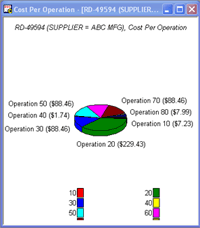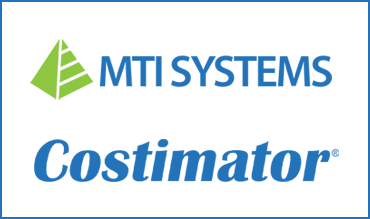-
-
Phone: 413-733-1972
Cost Estimating Saves OEMs Time and Money
Cost Estimating Saves OEMs Time and Money
 Computer-aided cost-estimating software has become more powerful and versatile in the past decade, allowing it to be used in a variety of extremely innovative ways. New features and uses are significantly boosting cost-estimating accuracy and increasing profits at both contract manufacturers and original equipment manufacturers that make some parts in-house and purchase others.
Computer-aided cost-estimating software has become more powerful and versatile in the past decade, allowing it to be used in a variety of extremely innovative ways. New features and uses are significantly boosting cost-estimating accuracy and increasing profits at both contract manufacturers and original equipment manufacturers that make some parts in-house and purchase others.
As significantly, CACE is employed at some companies to help cut waste, increase efficiency and boost profits beyond the cost-estimating department, in areas such as job scheduling, shop floor management, quality control and product design.
The most recent CACE developments are those that support purchasing and cost management. In fact, many manufacturers are using their CACE systems to improve efficiency in ways that support the company-wide implementation of lean manufacturing methods.
The Real Cost Concept
One of the hottest trends in CACE is OEMs using the systems to determine the "real cost" of machined or fabricated parts they purchase from suppliers. The prices OEMs pay for these parts are often "market prices," or the prices the market bears at that given point in time, regardless of the actual, or real, cost of making the parts. However, after receiving accurate costing data through a CACE system, purchasing agents are able to set realistic target prices for formulating and sending out RFQs (requests for quotes) to their suppliers. The result is a more efficient and cost effective RFQ process and, ultimately, lower part costs.
 For example, a Midwestern heavy-equipment manufacturer used a CACE system to calculate the real cost of a custom chassis part it outsources. The system came up with a real cost of $12 for the part; the manufacturer had been paying $20. The OEMs purchasing manager first reviewed the CACE system's information with his current supplier, then sent out an RFQ to several other suppliers, using the $12 figure as his target price. The result was an $8.25 per-part cost savings (one supplier came in under the target price), equating to a $66,000 annual cost savings on that one part alone.
For example, a Midwestern heavy-equipment manufacturer used a CACE system to calculate the real cost of a custom chassis part it outsources. The system came up with a real cost of $12 for the part; the manufacturer had been paying $20. The OEMs purchasing manager first reviewed the CACE system's information with his current supplier, then sent out an RFQ to several other suppliers, using the $12 figure as his target price. The result was an $8.25 per-part cost savings (one supplier came in under the target price), equating to a $66,000 annual cost savings on that one part alone.
Shop-rate calculators that are incorporated in some CACE software allow users to determine shop rates, including labor costs, associated with the quote of a specific part's production. As shown, some systems have default averages for shop costs such as insurance and utilities to better pin down the shop rate.
When "real costing" parts and negotiating lower per part prices, it is important to check on the capabilities and track record of unfamiliar subcontractors. A CACE system will give you a reasonable price for manufacturing, but it cannot assure the delivery of quality parts. The OEM cited was reasonably assured of receiving a quality product, because it previously had worked with the lower-bidding subcontractor.
Contract manufacturers can use CACE systems to their advantage when negotiating with their customers. By having detailed cost-estimating reports, they can justify quoted prices, thereby holding, or even increasing, profit margins.
Wayne Carroll, owner of Carroll Machine Works, Pasadena, Texas, does the estimating for his precision machine shop, which serves a variety of large manufacturers in sectors such as aerospace, petrochemical and oil field. He said having a CACE estimate in hand and knowing a part's real cost helps him to "resist the temptation" to over aggressively rebid a job for a customer that doesn't like his first quote, trying to cut corners and lower his price. "I know what my manufacturing costs will be, so it's much easier to say 'no thanks,'" Carroll said. He added that using CACE has virtually eliminated getting involved in "loser" jobs.
In an interesting twist to the real-cost trend, some OEMs that purchase a large dollar volume of parts are requiring their suppliers to use the same estimating system in an effort to create a "standard estimating language" between the two, streamlining the buying process.
 The most recent advancement in CACE technology that supports purchasing applications is the shop-rate calculator. This program is built into higher-end CACE systems and gives buyers (OEMs) and sellers (contract manufacturers) the ability to scientifically determine shop rates, including labor and burden, in the U.S. and throughout the world.
The most recent advancement in CACE technology that supports purchasing applications is the shop-rate calculator. This program is built into higher-end CACE systems and gives buyers (OEMs) and sellers (contract manufacturers) the ability to scientifically determine shop rates, including labor and burden, in the U.S. and throughout the world.
A detailed process plan of a part's production, derived from MTI Systems' Costimator software. This particular program allows the user to view more than one process plan simultaneously, so different methods of making a part can be easily compared, as can two or more possible suppliers of a part.
Shop-rate calculators help OEMs locate the most cost-efficient suppliers and enable their purchasing departments to negotiate better pricing. Some CACE systems take this to a higher level and allow the end user to almost instantaneously compare what parts would cost if they were made in different parts of the world.
 This data also helps the multiple-location contract manufacturer. It might use this feature to determine which of its plants would be most time- and cost-effective to make the part. Some contract manufacturers even use the shop-rate calculator to determine the shop rates of its competitors in an attempt to estimate what they might be bidding for a job.
This data also helps the multiple-location contract manufacturer. It might use this feature to determine which of its plants would be most time- and cost-effective to make the part. Some contract manufacturers even use the shop-rate calculator to determine the shop rates of its competitors in an attempt to estimate what they might be bidding for a job.
The cost estimate of a part's production based on the information generated from the process plan depicted above. If multiple process plans for different methods or various suppliers were run by a person, he could compare costs to help him make a buying decision.
Beyond Job Quoting
CACE technology and applications are advancing at such a rapid pace that many developments have gone unreported. In fact, some companies prefer to keep their new applications under wraps, to give them a competitive edge.
Using breakthroughs in system integration, such as open database connectivity (ODBC)—a feature that enables a native link to client server systems such as SQL Server and Oracle—the more advanced CACE systems can export feeds, speeds, labor standards and other data to manufacturing resource planning (MRP or MRPII) systems, enterprise resource planning (ERP) systems and other scheduling and management systems. The accurate data generated is vital in the front end of the planning and scheduling process. Such electronic links could dramatically increase a company's overall efficiency. The links for front-ending that are fastest and easiest to implement are the ones between two ODBC-capable systems.
Check with the sales or technical support department of your ERP or MRP vendor to find out which CACE systems are candidates for such a linkage and what is required to connect your management system to a CACE system.
Meanwhile, although a CACE system is not a design technology, per se, it has been utilized in the first stages of designing parts. By playing "what if?," an estimator can quickly compare the machining and labor costs for different design options and determine the most cost-effective option. The cost estimators at some subcontractors even use CACE systems to work with their customers on designs to bring down manufacturing costs.
Northeast Manufacturing Inc., Stoneham, Mass., had a customer supply a design for a piece of laser equipment slated to fly on the NASA space shuttle. The design dictated an expensive target price. A Northeast engineer used CACE to formulate subtle changes to the part drawing to lower the cost of producing the part. For example, instead of needing a 1⁄4" endmill to machine certain facets of the part, Northeast was able to apply a 3⁄4" endmill.
"These changes increased our cutting efficiency and significantly reduced the machine time," said Chris Lobdell, Northeast's president.
Further, quality-control departments can use CACE systems for ISO certification and recertification. A CACE system with a flexible database has the capability to document and certify manufacturing processes and produce traceable documentation for inspection, as required by ISO guidelines.
A CACE system employed by Will- Burt Co., an Orrville, Ohio, subcontractor to the heavy-equipment industry, enabled the company's quality-assurance department to create process plan procedures that conform to ISO 9000 standards.
"We purchased a CACE system to assist us in our efforts to gain ISO certification," noted Kevin Baldwin, Will- Burt's OEM process engineering manager. "Now that we've achieved it, CACE not only is helping us to continue to meet ISO standards, it's helping us to generate significant gains in shop-floor efficiency, productivity and profitability."
Also, CACE systems can be used to accurately estimate the costs of manufacturing parts on different work centers and machines under consideration for purchase.
CACE and Lean Manufacturing
Lean manufacturing is a series of techniques applied company-wide for identifying and eliminating manufacturing activities that add no value to a company's manufacturing processes and for increasing manufacturing efficiency and resources. If it helps other areas (scheduling, planning, design engineering, etc.) become more efficient, it can add significantly to a company's ability to achieve kaizen, the cross-company improvements and added efficiencies that are characteristic of lean manufacturing.
An electronic link to scheduling and management systems will further promote kaizen. And more advanced CACE systems could support many of the important action steps associated with lean manufacturing. A CACE system can support lean efficiency through its estimating accuracy and consistency. For example, a CACE system can help break manufacturing bottlenecks. CACE not only helps find the fastest, most efficient manufacturing processes, it also provides the front-end data needed for efficient scheduling.
A CACE system can also support cellular manufacturing by providing the data needed to accurately schedule and coordinate the operation of multiple cells, with the potential to vastly improve their efficiency.
The accurate process plans and routings produced through CACE, as well as CACE data transferred to an ERP system, supports the advanced planning and the smooth flow of inventory. This can work to support just-in-time manufacturing.
Clearly, CACE software can do more for manufacturers than just help them quote jobs. And given these competitive times, now might be the time to think outside the CACE box.
About the Author
Tom Charkiewicz is chief technical officer of MTI Systems Inc., a West Springfield, Mass-based company he and two others founded in 1982. For more information about the company's CACE and process-planning products, call (800) 644-4318, visit www.mtisystems.com.
Copyright © 2003 Cutting Tool Engineering

Costimator®
Cost Estimating Software for Manufacturing
-
Cost Estimating Sheet Metal
-
Estimating for Machined Parts
-
Quoting for Machining and Fabrication




